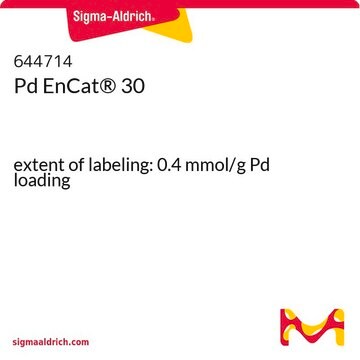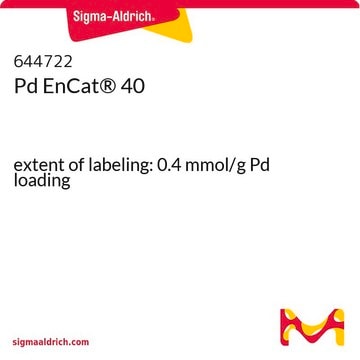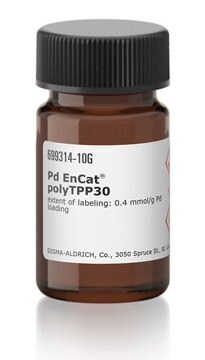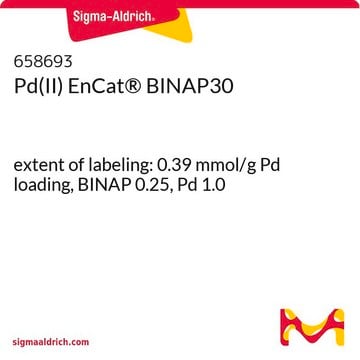644706
Pd EnCat® TPP30
extent of labeling: 0.4 mmol/g Pd loading, TPP 0.8, Pd 1.0
Sinonimo/i:
Palladium acetate and triphenylphosphine, microencapsulated in polyurea matrix
About This Item
Prodotti consigliati
contiene
0.26-0.35 mmol/g phosphorous
0.37-0.44 mmol/g palladium
Composizione
Pd, 1.0
TPP, 0.8
Impiego in reazioni chimiche
core: palladium
reaction type: Buchwald-Hartwig Cross Coupling Reaction
reaction type: Heck Reaction
reaction type: Hiyama Coupling
reaction type: Negishi Coupling
reaction type: Sonogashira Coupling
reaction type: Stille Coupling
reaction type: Suzuki-Miyaura Coupling
reagent type: catalyst
Grado di funzionalizzazione
0.4 mmol/g Pd loading
Descrizione generale
Applicazioni
- Aryl iodides and bromides with terminal alkynes to form the corresponding coupling products under copper-free conditions.
- Bromobenzotriazoles and arylacetylenes in the presence of 1,5-diazabicyclo[5.4.0]undecene-5-ene (DBU) and copper iodide to form 2H-benzo[d][1,2,3]triazole derivatives.
Caratteristiche e vantaggi
- low residual metal levels in crude product
- easy recovery of catalyst
- compatibility of immobilized metal with various ligands to effect C-C bond forming reactions
- safer and easier to handle than Pd/C for hydrogenation
- efficiency and economy gains through recovery and recycling
Altre note
Note legali
Avvertenze
Warning
Indicazioni di pericolo
Consigli di prudenza
Classi di pericolo
Aquatic Chronic 3 - Carc. 2 - Flam. Sol. 2 - Repr. 2 - STOT RE 2 Oral
Organi bersaglio
Liver,Kidney
Codice della classe di stoccaggio
4.1B - Flammable solid hazardous materials
Classe di pericolosità dell'acqua (WGK)
WGK 3
Punto d’infiammabilità (°F)
-9.4 - -7.6 °F
Punto d’infiammabilità (°C)
-23 - -22 °C
Dispositivi di protezione individuale
dust mask type N95 (US), Eyeshields, Gloves
Certificati d'analisi (COA)
Cerca il Certificati d'analisi (COA) digitando il numero di lotto/batch corrispondente. I numeri di lotto o di batch sono stampati sull'etichetta dei prodotti dopo la parola ‘Lotto’ o ‘Batch’.
Possiedi già questo prodotto?
I documenti relativi ai prodotti acquistati recentemente sono disponibili nell’Archivio dei documenti.
Contenuto correlato
Homogeneous palladium catalysts are widely utilized due to their versatility, reactivity and functional group tolerance.
Il team dei nostri ricercatori vanta grande esperienza in tutte le aree della ricerca quali Life Science, scienza dei materiali, sintesi chimica, cromatografia, discipline analitiche, ecc..
Contatta l'Assistenza Tecnica.





![[Pd(OAc)2]3 reagent grade, 98%](/deepweb/assets/sigmaaldrich/product/structures/508/249/99a0ef2c-b77c-4d73-8ed9-0cca05b6b41f/640/99a0ef2c-b77c-4d73-8ed9-0cca05b6b41f.png)




